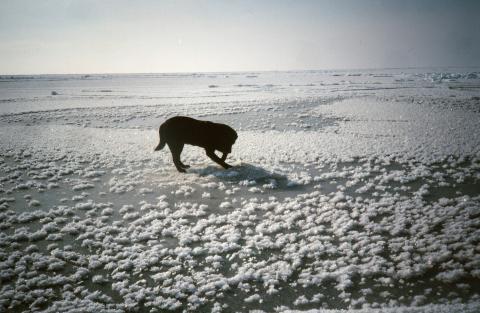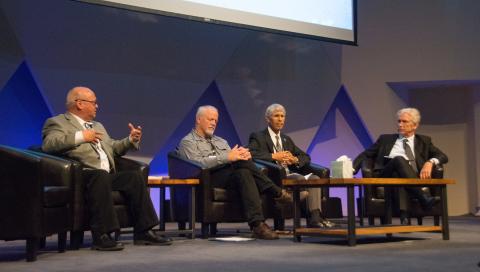In the 1970s, the International Whaling Commission’s scientists met at the University of Cambridge to consider the status of the world’s whale populations. For over 700 years, Cambridge had been a major force in establishing science as a powerful tool for understanding the world and informing public policies. The university also established academic and social traditions that are held with great tenacity. And so, scientists and decision-makers gathered at that beacon of science and tradition and concluded that there were less than 1,000 bowhead whales in the Arctic and that it was imperative to impose a moratorium on their harvest. The Inupiaq whalers of northern Alaska—whose tradition of harvesting bowheads had started some 800 or more years before Cambridge was founded—had developed their own knowledge and social traditions centered around sea ice and the whales and other animals found there. Harvesting whales was at the core of Inupiaq identity and food security, and the moratorium left many whalers despondent.
Biologists were sent north to verify the population numbers, but they were challenged by the extreme difficulty of enumerating whales migrating through heavy ice cover. Their preliminary estimates were consistent with the International Whaling Commission’s dire outlook. Nonetheless, an unlikely alliance formed between the Inupiaq whalers and the field biologists. The biologists quickly realized that their safety and data collection depended on listening to the whaling captains. The whalers shared their deep knowledge—developed over thousands of years—of the behavior of the ice.
Observing how the data were collected and interpreted, the whalers quickly realized that substantial numbers of whales were not being counted by the scientists. The biologists can be forgiven for imagining that, when the sea appeared to be completely ice covered, no whales were passing by as surfacing to breathe was seemingly impossible. On the other hand, imaginings should provoke hypotheses, not conclusions. And those hypotheses should have been tested. In fact, they had been tested by centuries of observations by Inupiaq whalers. Those observations had taught the whalers that bowheads continue passing under ice that is more than thick enough to walk on. In those circumstances, the whales—whose nostrils are at the top of their heads—push up on the ice until it cracks, take a breath, submerge, and continue on their migration. The ice where they breathed settles down, leaving only a narrow crack as evidence. After considerably more research, the scientists confirmed what the whalers knew: there were, in fact, many more whales than the scientists originally estimated. The traditional harvest is sustainable and ongoing and, today, the whalers and scientists collaborate to monitor and study the whales.

Making unlikely alliances intentional is part of what motivated the Study of Environmental Arctic Change (SEARCH) to convene Arctic scientists, Indigenous Peoples, and policymakers from 17 countries in a novel conference. For three days, 400 attendees collaboratively envisioned the information that will be needed to inform Arctic policy in the coming decades. The Arctic Futures 2050 Conference focused on information needed, how that information could best be conveyed, and how to work collaboratively to effectively inform decisions. We convinced the scientists to mostly let go of their PowerPoint lectures, we asked Indigenous Peoples to make long trips to Washington, D.C., and we wheedled and cajoled policy staff to leave their offices for a few hours. Over three days, we discussed what we know, how we know it, and what we need to know to respond to the rapid changes taking place in the Arctic. We made good progress but face challenges in navigating a path forward.

The bowhead story points to the tremendous value of bringing multiple perspectives and ways of knowing together and highlights the risks and lost opportunities if we fail to do so. Many large and difficult problems stimulate and benefit from cross-disciplinary science and integrated knowledge systems. Indeed, our understanding of climate change has advanced through collaborations of physicists, chemists, biologists, paleontologists, anthropologists, and more. Bringing together such experts always requires special efforts in communication, however, because experts struggle to penetrate each other’s specialized vocabulary and cultures. The work of coming together to span boundaries requires concerted effort.
Thomas Kuhn, renowned philosopher of science, pointed out that those who create new paradigms have to write and speak in broadly accessible terms. Specialized vocabularies—shared by a restricted subset of scholars—only evolve as the ramifications of the paradigm shift are explored and refined. Thus, as the body of knowledge grows, we inevitably divide into more and more isolated disciplines, and the challenge to synthesize across those becomes greater and greater. Today, as the earth’s environments hurdle to unprecedented and dangerous states, we are blessed with detailed and specialized knowledge, and we are cursed with limited abilities to share what we know.

Climate change has compelled many specialists to learn each other’s language so that they can effectively collaborate. Climate models, for example, have to incorporate knowledge from many disciplines, and modelers enjoy learning what is happening in the otherwise siloed specialties. To synthesize our understanding of environmental change in the Arctic and to predict its future course, SEARCH is reversing the process in which the broad language of new paradigms gives way to narrower and narrower communications. SEARCH is helping experts convey their specialized knowledge of the changing system in succinct and accessible briefs shared with policymakers. SEARCH also recognizes that effectively tackling environmental change calls for deeper communication and collaboration with those who hold other types of knowledge, in particular traditional ecological knowledge and knowledge of policymaking. Scientific, traditional, and policymaking knowledge are specialties needed to respond to environmental change; thus, we need even broader collaborations than across scientific disciplines.
The possibility of a moratorium on traditional whaling posed an urgent threat to the cultural identity and food security of the Inupiaq in Alaska. Combining the knowledge of the whalers, scientists, and policymakers eventually clarified the situation and obviated the need for a moratorium. Today, rapid environmental change in the Arctic poses many threats to people in the Arctic and around the globe. We must learn from the whaling example and harness Indigenous, scientific, and policy expertise to stave off the myriad threats posed by a rapidly warming Arctic.